Page 146 of 376
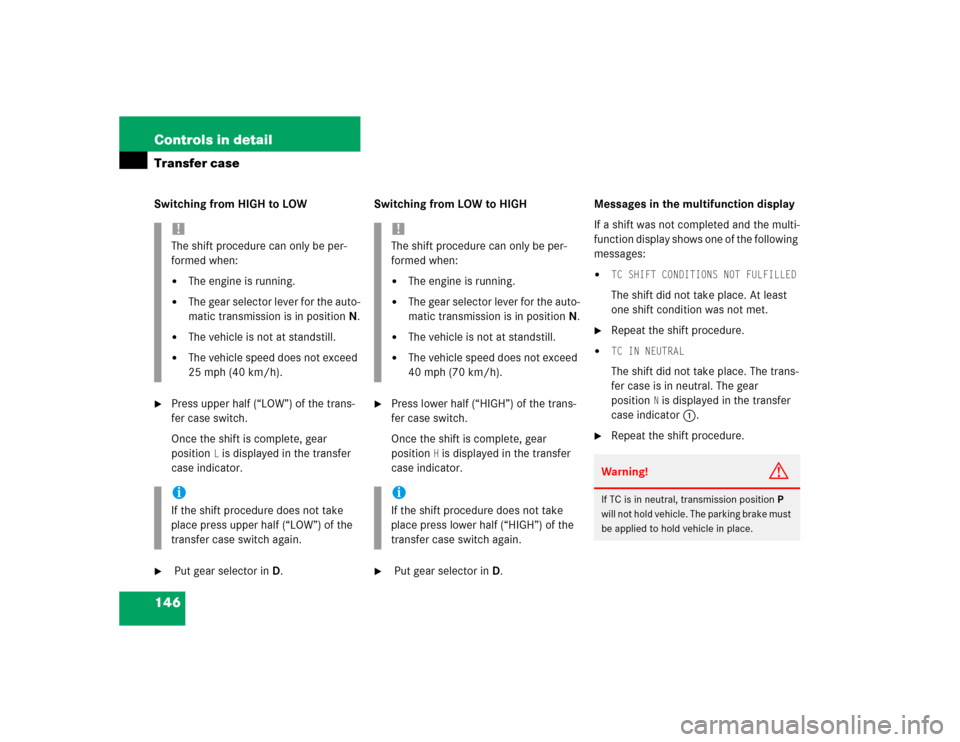
146 Controls in detailTransfer caseSwitching from HIGH to LOW�
Press upper half (“LOW”) of the trans-
fer case switch.
Once the shift is complete, gear
position
L is displayed in the transfer
case indicator.
�
Put gear selector in D.Switching from LOW to HIGH
�
Press lower half (“HIGH”) of the trans-
fer case switch.
Once the shift is complete, gear
position
H is displayed in the transfer
case indicator.
�
Put gear selector in D.Messages in the multifunction display
If a shift was not completed and the multi-
function display shows one of the following
messages:
�
TC SHIFT CONDITIONS NOT FULFILLEDThe shift did not take place. At least
one shift condition was not met.
�
Repeat the shift procedure.
�
TC IN NEUTRAL The shift did not take place. The trans-
fer case is in neutral. The gear
position
N is displayed in the transfer
case indicator1.
�
Repeat the shift procedure.
!The shift procedure can only be per-
formed when:�
The engine is running.
�
The gear selector lever for the auto-
matic transmission is in positionN.
�
The vehicle is not at standstill.
�
The vehicle speed does not exceed
25 mph (40 km/h).
iIf the shift procedure does not take
place press upper half (“LOW”) of the
transfer case switch again.
!The shift procedure can only be per-
formed when:�
The engine is running.
�
The gear selector lever for the auto-
matic transmission is in positionN.
�
The vehicle is not at standstill.
�
The vehicle speed does not exceed
40 mph (70 km/h).
iIf the shift procedure does not take
place press lower half (“HIGH”) of the
transfer case switch again.
Warning!
G
If TC is in neutral, transmission positionP
will not hold vehicle. The parking brake must
be applied to hold vehicle in place.
Page 148 of 376
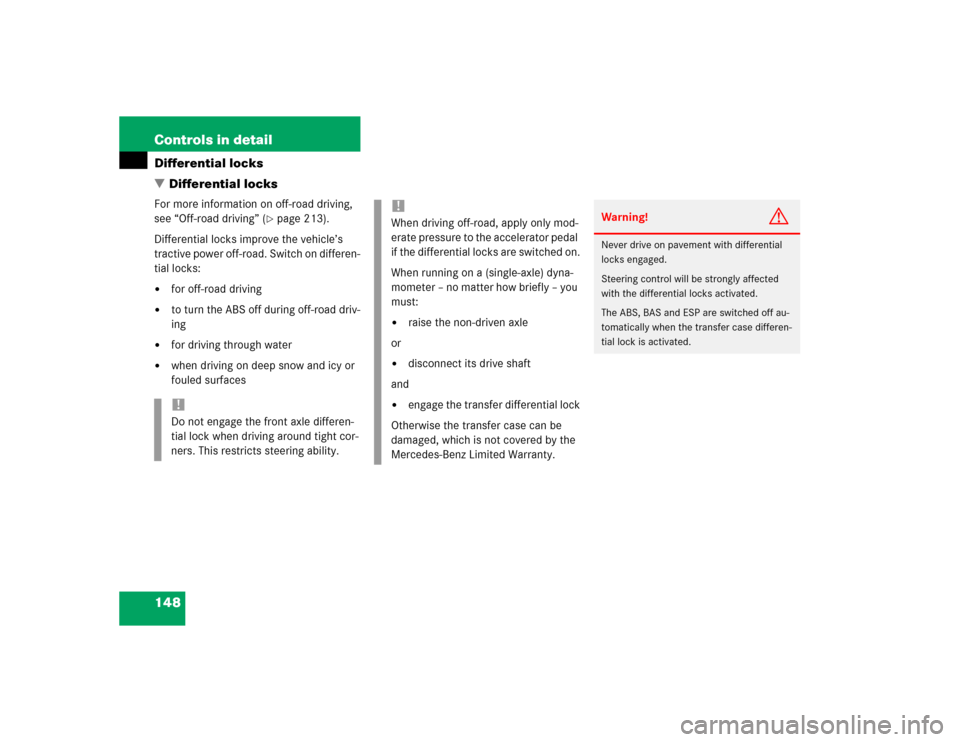
148 Controls in detailDifferential locks
�Differential locksFor more information on off-road driving,
see “Off-road driving” (
�page 213).
Differential locks improve the vehicle’s
tractive power off-road. Switch on differen-
tial locks:
�
for off-road driving
�
to turn the ABS off during off-road driv-
ing
�
for driving through water
�
when driving on deep snow and icy or
fouled surfaces!Do not engage the front axle differen-
tial lock when driving around tight cor-
ners. This restricts steering ability.
!When driving off-road, apply only mod-
erate pressure to the accelerator pedal
if the differential locks are switched on.
When running on a (single-axle) dyna-
mometer – no matter how briefly – you
must:�
raise the non-driven axle
or
�
disconnect its drive shaft
and
�
engage the transfer differential lock
Otherwise the transfer case can be
damaged, which is not covered by the
Mercedes-Benz Limited Warranty.
Warning!
G
Never drive on pavement with differential
locks engaged.
Steering control will be strongly affected
with the differential locks activated.
The ABS, BAS and ESP are switched off au-
tomatically when the transfer case differen-
tial lock is activated.
Page 150 of 376
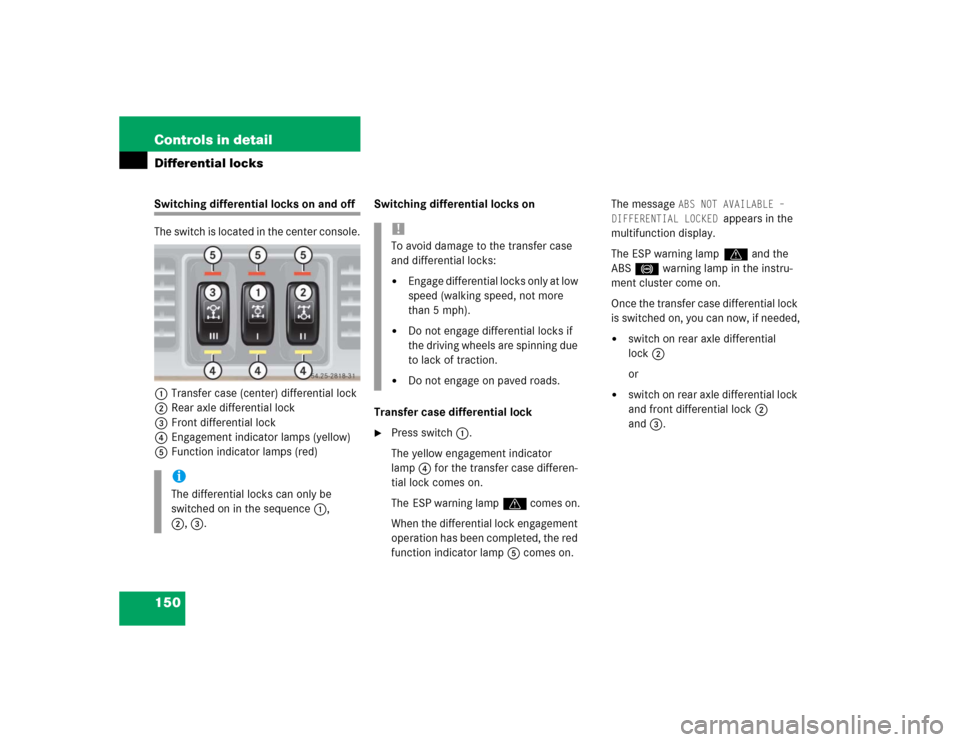
150 Controls in detailDifferential locksSwitching differential locks on and off
The switch is located in the center console.
1Transfer case (center) differential lock
2Rear axle differential lock
3Front differential lock
4Engagement indicator lamps (yellow)
5Function indicator lamps (red)Switching differential locks on
Transfer case differential lock
�
Press switch1.
The yellow engagement indicator
lamp4 for the transfer case differen-
tial lock comes on.
The ESP warning lampv comes on.
When the differential lock engagement
operation has been completed, the red
function indicator lamp5 comes on.The message
ABS NOT AVAILABLE –
DIFFERENTIAL LOCKED
appears in the
multifunction display.
The ESP warning lampv and the
ABS- warning lamp in the instru-
ment cluster come on.
Once the transfer case differential lock
is switched on, you can now, if needed,
�
switch on rear axle differential
lock2
or
�
switch on rear axle differential lock
and front differential lock2
and3.
iThe differential locks can only be
switched on in the sequence 1,
2,3.
!To avoid damage to the transfer case
and differential locks:�
Engage differential locks only at low
speed (walking speed, not more
than 5 mph).
�
Do not engage differential locks if
the driving wheels are spinning due
to lack of traction.
�
Do not engage on paved roads.
Page 151 of 376
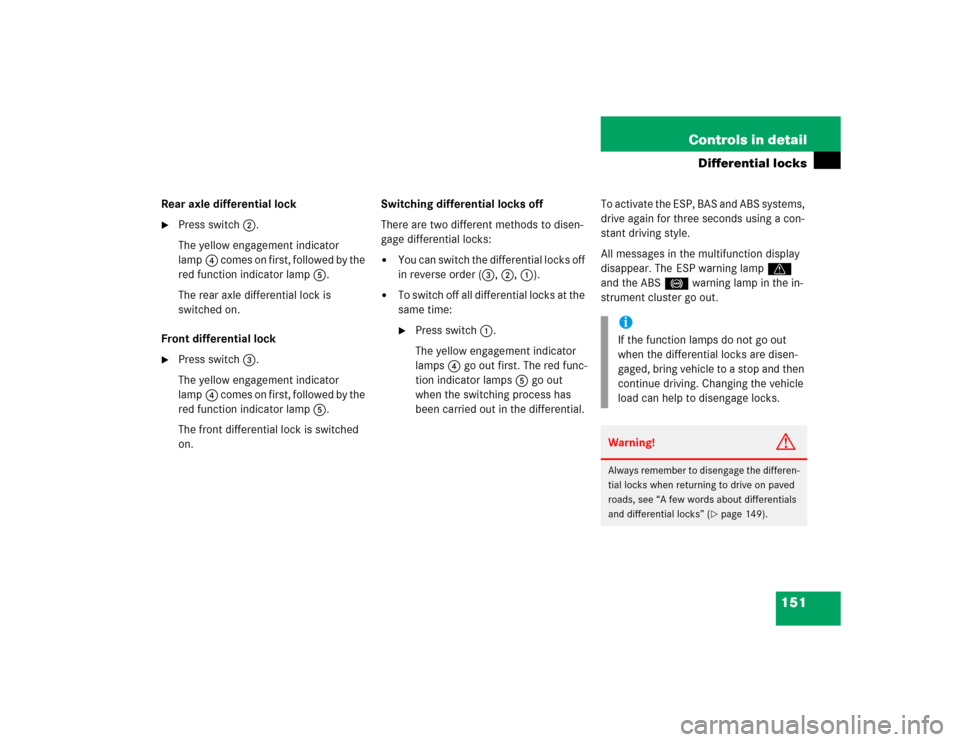
151 Controls in detail
Differential locks
Rear axle differential lock�
Press switch2.
The yellow engagement indicator
lamp4 comes on first, followed by the
red function indicator lamp5.
The rear axle differential lock is
switched on.
Front differential lock
�
Press switch 3.
The yellow engagement indicator
lamp4 comes on first, followed by the
red function indicator lamp5.
The front differential lock is switched
on. Switching differential locks off
There are two different methods to disen-
gage differential locks:
�
You can switch the differential locks off
in reverse order (3, 2,1).
�
To switch off all differential locks at the
same time:�
Press switch1.
The yellow engagement indicator
lamps4 go out first. The red func-
tion indicator lamps5 go out
when the switching process has
been carried out in the differential.To activate the ESP, BAS and ABS systems,
drive again for three seconds using a con-
stant driving style.
All messages in the multifunction display
disappear. The ESP warning lampv
and the ABS- warning lamp in the in-
strument cluster go out.
iIf the function lamps do not go out
when the differential locks are disen-
gaged, bring vehicle to a stop and then
continue driving. Changing the vehicle
load can help to disengage locks. Warning!
G
Always remember to disengage the differen-
tial locks when returning to drive on paved
roads, see “A few words about differentials
and differential locks” (
�page 149).
Page 152 of 376
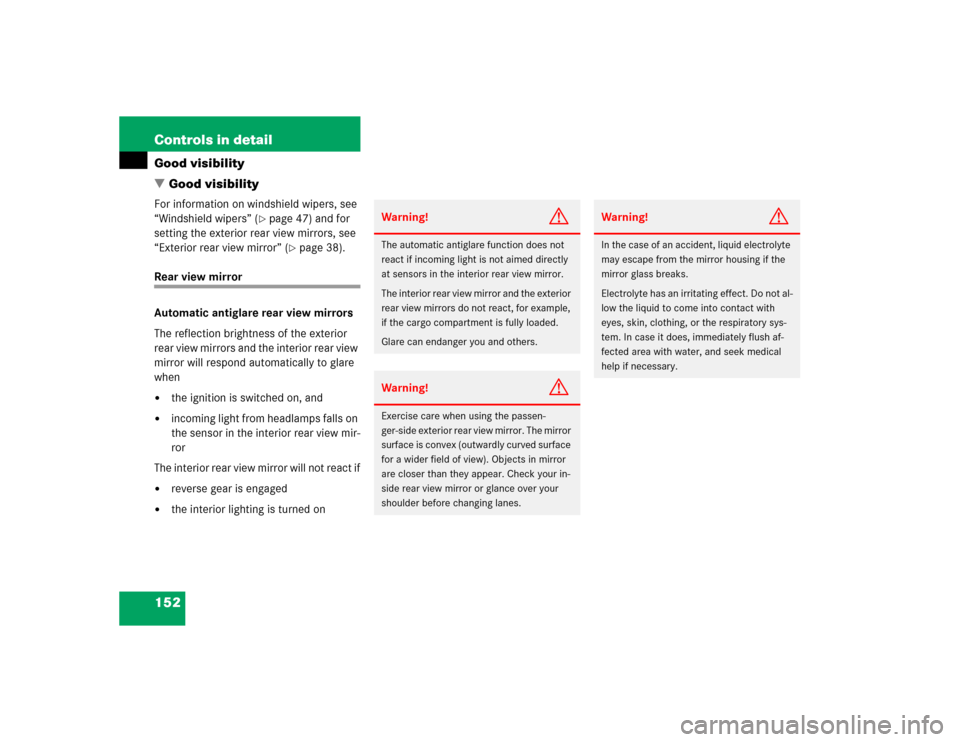
152 Controls in detailGood visibility
�Good visibilityFor information on windshield wipers, see
“Windshield wipers” (
�page 47) and for
setting the exterior rear view mirrors, see
“Exterior rear view mirror” (
�page 38).
Rear view mirror
Automatic antiglare rear view mirrors
The reflection brightness of the exterior
rear view mirrors and the interior rear view
mirror will respond automatically to glare
when �
the ignition is switched on, and
�
incoming light from headlamps falls on
the sensor in the interior rear view mir-
ror
The interior rear view mirror will not react if
�
reverse gear is engaged
�
the interior lighting is turned on
Warning!
G
The automatic antiglare function does not
react if incoming light is not aimed directly
at sensors in the interior rear view mirror.
The interior rear view mirror and the exterior
rear view mirrors do not react, for example,
if the cargo compartment is fully loaded.
Glare can endanger you and others.Warning!
G
Exercise care when using the passen-
ger-side exterior rear view mirror. The mirror
surface is convex (outwardly curved surface
for a wider field of view). Objects in mirror
are closer than they appear. Check your in-
side rear view mirror or glance over your
shoulder before changing lanes.
Warning!
G
In the case of an accident, liquid electrolyte
may escape from the mirror housing if the
mirror glass breaks.
Electrolyte has an irritating effect. Do not al-
low the liquid to come into contact with
eyes, skin, clothing, or the respiratory sys-
tem. In case it does, immediately flush af-
fected area with water, and seek medical
help if necessary.
Page 154 of 376
154 Controls in detailGood visibilitySun visors
The sun visors protect you from sun glare
while driving.
1Sun visor
2Mounting
�
Swing sun visors1 down to protect
against sun glare.
�
If sunlight enters through a side win-
dow, disengage visor1 from inner
mounting2 and pivot it to the side.3Mirror cover
4Mirror lamp
�
Make sure the ignition is switched on
and that the sun visor is engaged in
mounting2.
�
Open mirror cover3.
Mirror lamps4 switch on.
Warning!
G
Do not use the vanity mirror while driving.
Keep the mirrors in the sun visors closed
while vehicle is in motion. Reflected glare
can endanger you and others.
Page 158 of 376
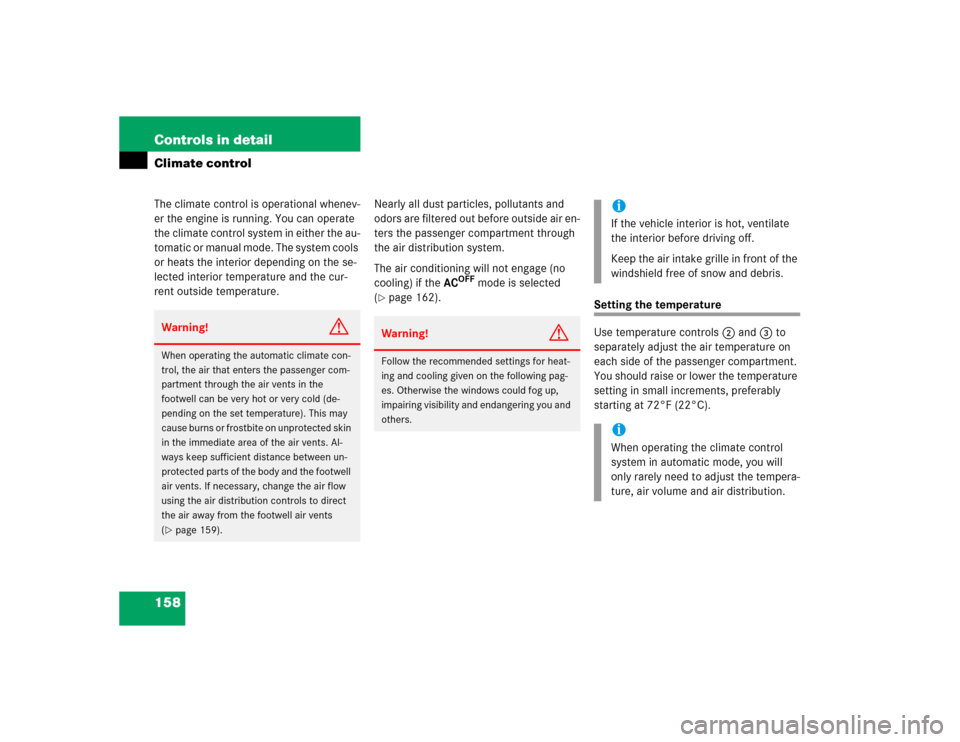
158 Controls in detailClimate controlThe climate control is operational whenev-
er the engine is running. You can operate
the climate control system in either the au-
tomatic or manual mode. The system cools
or heats the interior depending on the se-
lected interior temperature and the cur-
rent outside temperature.Nearly all dust particles, pollutants and
odors are filtered out before outside air en-
ters the passenger compartment through
the air distribution system.
The air conditioning will not engage (no
cooling) if the AC
OFF
mode is selected
(
�page 162).
Setting the temperature
Use temperature controls2 and3 to
separately adjust the air temperature on
each side of the passenger compartment.
You should raise or lower the temperature
setting in small increments, preferably
starting at 72°F (22°C).
Warning!
G
When operating the automatic climate con-
trol, the air that enters the passenger com-
partment through the air vents in the
footwell can be very hot or very cold (de-
pending on the set temperature). This may
cause burns or frostbite on unprotected skin
in the immediate area of the air vents. Al-
ways keep sufficient distance between un-
protected parts of the body and the footwell
air vents. If necessary, change the air flow
using the air distribution controls to direct
the air away from the footwell air vents
(�page 159).
Warning!
G
Follow the recommended settings for heat-
ing and cooling given on the following pag-
es. Otherwise the windows could fog up,
impairing visibility and endangering you and
others.
iIf the vehicle interior is hot, ventilate
the interior before driving off.
Keep the air intake grille in front of the
windshield free of snow and debris.iWhen operating the climate control
system in automatic mode, you will
only rarely need to adjust the tempera-
ture, air volume and air distribution.
Page 160 of 376
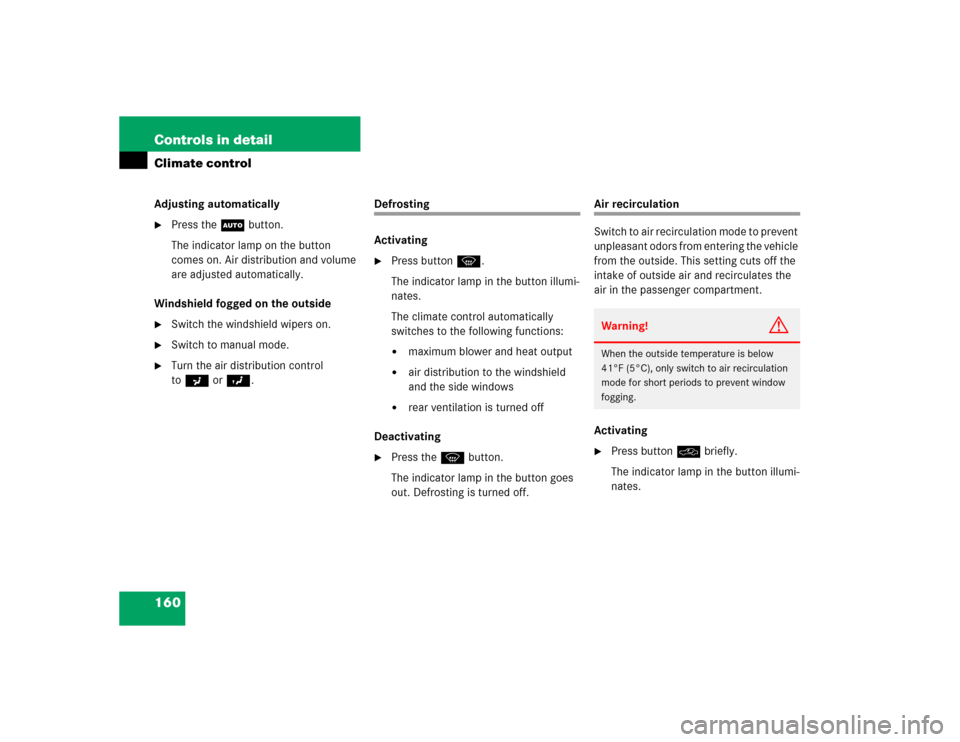
160 Controls in detailClimate controlAdjusting automatically�
Press theU button.
The indicator lamp on the button
comes on. Air distribution and volume
are adjusted automatically.
Windshield fogged on the outside
�
Switch the windshield wipers on.
�
Switch to manual mode.
�
Turn the air distribution control
toa orY.
Defrosting
Activating�
Press button P.
The indicator lamp in the button illumi-
nates.
The climate control automatically
switches to the following functions:�
maximum blower and heat output
�
air distribution to the windshield
and the side windows
�
rear ventilation is turned off
Deactivating
�
Press the P button.
The indicator lamp in the button goes
out. Defrosting is turned off.
Air recirculation
Switch to air recirculation mode to prevent
unpleasant odors from entering the vehicle
from the outside. This setting cuts off the
intake of outside air and recirculates the
air in the passenger compartment.
Activating�
Press button O briefly.
The indicator lamp in the button illumi-
nates.Warning!
G
When the outside temperature is below
41°F (5°C), only switch to air recirculation
mode for short periods to prevent window
fogging.